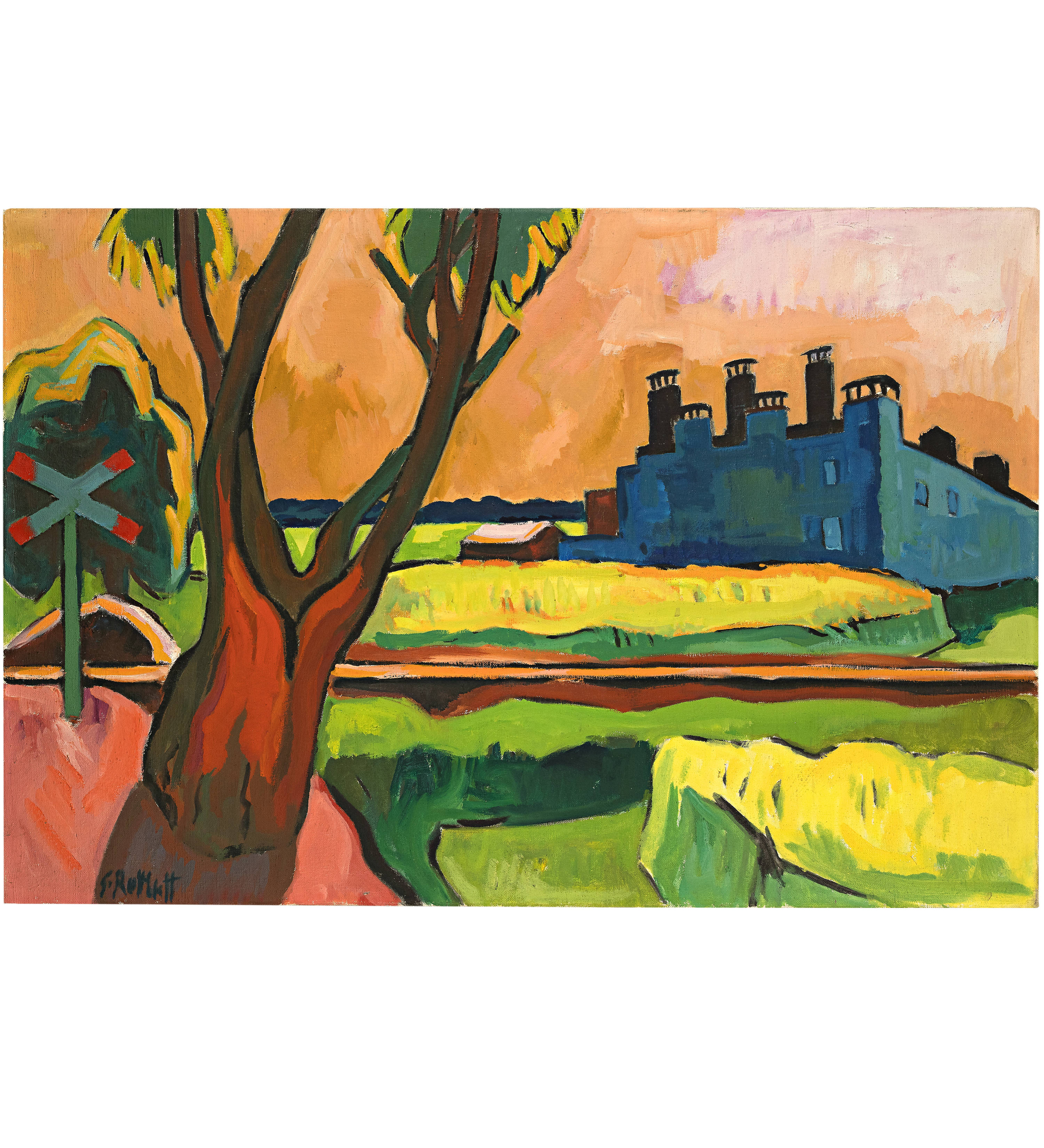- EN
Log in
- Live Auctions
- Past auctions
- More
- Gallery
- Art Dealing
- Publishing
- Kornfeld today
- The Story of Kornfeld
- Information
Note: The image cannot be displayed for legal reasons. For more information, see the PDF of the catalogue: Link to PDF
Rottluff 1884 - 1976 Berlin
1937
Oil on canvas
76x112 cm
Signed by the artist "S-Rottluff" lower left. Signed on the reverse at the top of the stretcher with a brush in black, titled and inscribed with work number "Schmidt=Rottluff "Fischräucherei am Bahngleis" ((3710))"
Will Grohmann, Karl Schmidt-Rottluff, Stuttgart 1956, pag. 303
The painting is registered in the archive of the Karl and Emy Schmidt-Rottluff Foundation, Berlin
Studio of the artist, acquired there from
Private collection Lower Saxony
Frankfurt am Main 1949, Frankfurter Kunstkabinett Hanna Bekker vom Rath, 1949
Hamburg 1974, Altonaer Museum, Schmidt-Rottluff, Gemälde, Landschaften aus 7 Jahrzehnten, cat. no. 30 reprod.
On the original stretcher, in the old nailing. In very good condition and fresh in colour
Schmidt-Rottluff found the motifs for the landscape paintings of the 1930s, as in the painting "Fischräucherei am Bahngleis" (Fish Smokehouse by the Railway Track), in the surroundings of his summer residence in the fishing village of Rumbke near Leba, in the extreme tip of Hinterpommern. The works reflect the artist's mood. They are influenced by the background of the difficult political circumstances and the resulting personal situation of the artist and may mostly be interpreted symbolically. Thus the tree in the foreground on the left with its broken bark can stand as a metaphor for Schmidt-Rottluff's wounding and humiliation. The defamation of his art in the year in which the present work was created reached its tragic climax with the removal of his works from museum ownership and the presentation of some of them in the "Degenerate Art" exhibition. The dark building of the fish smokehouse with its chimneys, on the right of the picture, resembles a prison with its control towers. It stands behind the railway track, which cuts through the landscape like a barrier. The signal at the railway crossing stands warningly in the way of the viewer's gaze. A characteristic of the landscape paintings of that time is the surreal, in this work reddish, shimmering light, as can also be seen in the painting "Fischerbucht" (Fishermen's Bay) from 1937 (Karl and Emy Schmidt-Rottluff Foundation Estate, Brücke Museum, Berlin).
1937
Öl auf Leinwand
76x112 cm
Unten links vom Künstler signiert "S·Rottluff". Rückseitig oben auf dem Keilrahmen mit Pinsel in Schwarz signiert, betitelt und mit Werknummer bezeichnet "Schmidt=Rottluff „Fischräucherei am Bahngleis“ ((3710))"
Will Grohmann, Karl Schmidt-Rottluff, Stuttgart 1956, pag. 303
Das Gemälde ist im Archiv der Karl und Emy Schmidt-Rottluff Stiftung, Berlin, registriert
Atelier des Künstlers, dort erworben von
Privatsammlung Niedersachsen
Frankfurt am Main 1949, Frankfurter Kunstkabinett Hanna Bekker vom Rath, 1949
Hamburg 1974, Altonaer Museum, Schmidt-Rottluff, Gemälde, Landschaften aus 7 Jahrzehnten,
Auf dem originalen Chassis, in der alten Nagelung. In sehr guter und farbfrischer Erhaltung
Die Motive der Landschaftsgemälde der 1930er Jahre fand Schmidt-Rottluff, wie im Gemälde "Fischräucherei am Bahngleis", in der Umgebung seiner Sommerbleibe im Fischerdorf Rumbke bei Leba, im äussersten Zipfel Hinterpommerns. Die Werke spiegeln die Stimmung des Künstlers wider. Sie sind geprägt vom Hintergrund der schwierigen politischen Verhältnisse und von der daraus folgenden persönlichen Situation des Künstlers und dürfen meist symbolisch gedeutet werden. So kann der links im Vordergrund stehende Baum mit seiner aufgebrochenen Rinde als Metapher für die Verwundung und Erniedrigung Schmidt-Rottluffs stehen. Die Diffamierung seiner Kunst im Entstehungsjahr des vorliegenden Werkes erreichte mit der Entfernung seiner Werke aus Museumsbesitz und der Präsentation einiger Arbeiten in der Ausstellung "Entartete Kunst" ihren tragischen Höhenpunkt. Das dunkle Gebäude der Fischräucherei mit seinen Kaminen, rechts im Bild, gleicht mit seinen Kontrolltürmen einem Gefängnis. Es steht hinter dem Bahngleis, das die Landschaft barrierenartig durchschneidet. Das Signal am Bahngleisübergang stellt sich dem Blick des Betrachters warnend in den Weg. Ein Merkmal in den Landschaftsbildern jener Zeit ist das surreal, in diesem Werk rötlich, schimmernde Licht, wie es auch im Gemälde "Fischerbucht" von 1937 (Nachlass Karl und Emy Schmidt-Rottluff Stiftung, Brücke-Museum, Berlin) zu sehen ist
Note: The image cannot be displayed for legal reasons. For more information, see the PDF of the catalogue: Link to PDF

